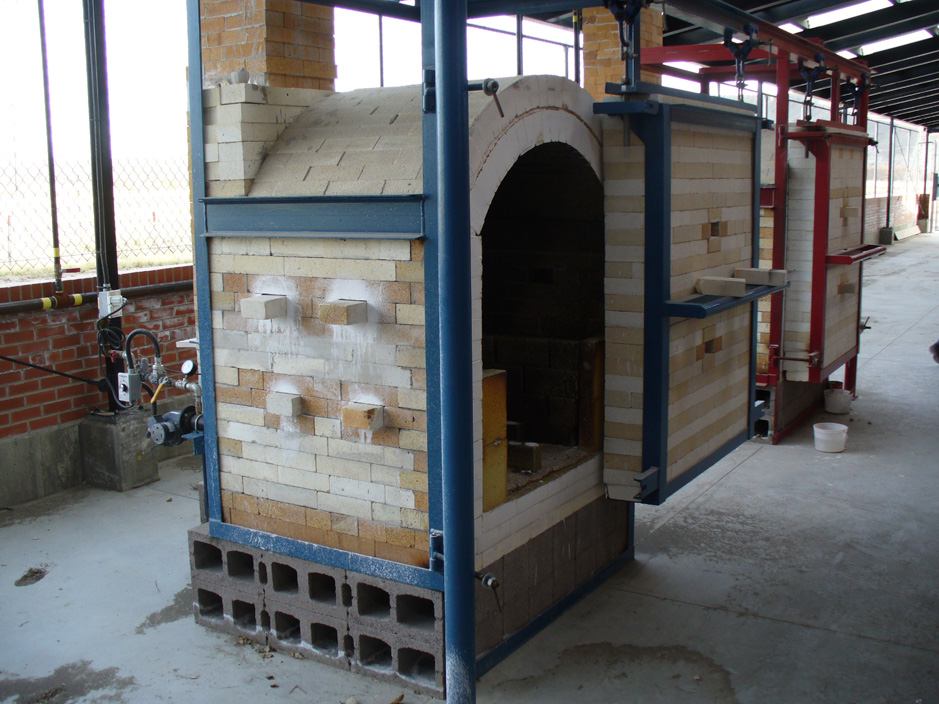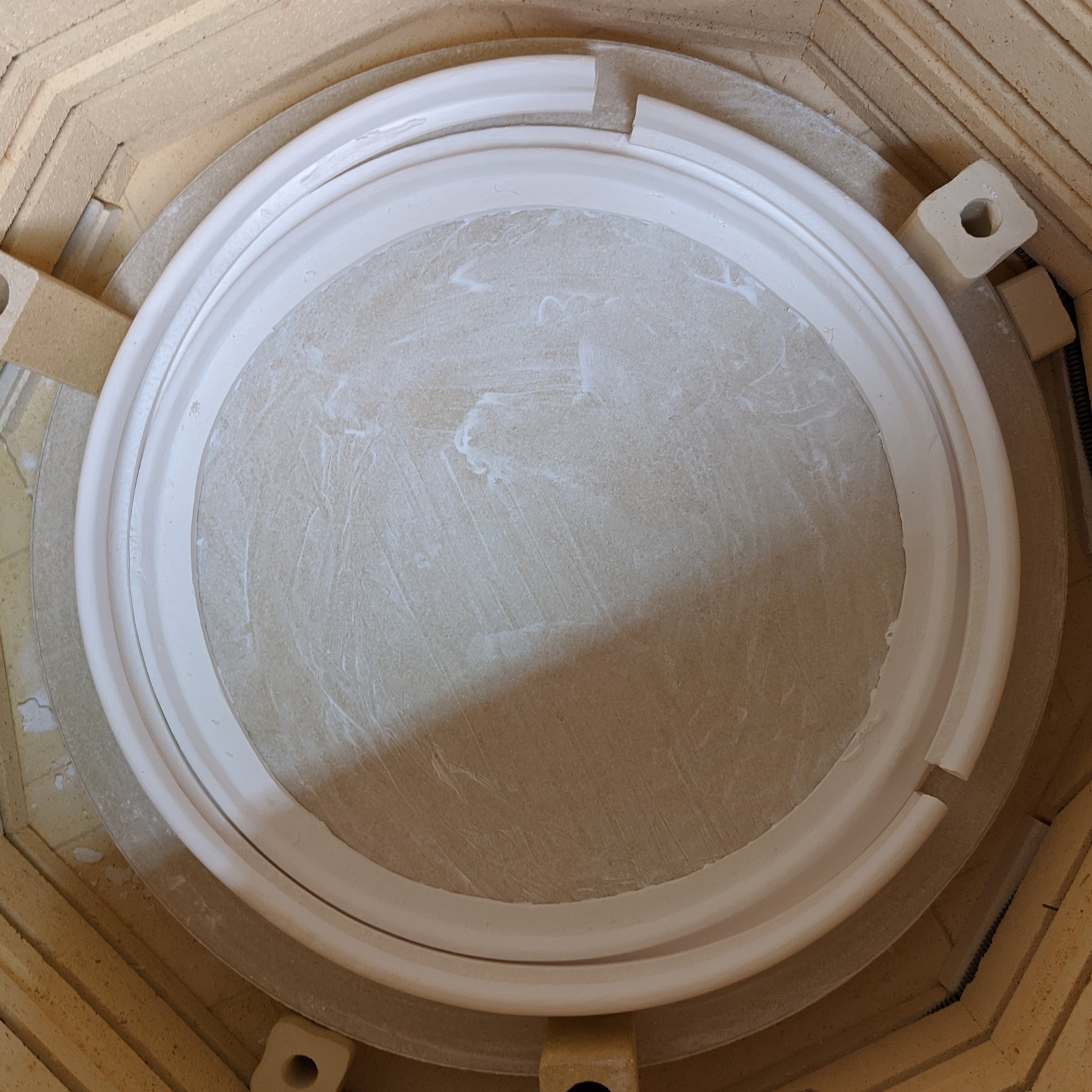| Monthly Tech-Tip | No tracking! No ads! | |
Kiln Firing
All types of ceramic are fired in a kiln to cement particles together to produce a hard and water and temperature resistant product.
Key phrases linking here: kiln firing - Learn more
Details
At it most basic level, firing is a process of heating a clay (or recipe of clays and minerals) to a temperature sufficient to fuse the particles together. However today, each type of ceramic has not only its own firing temperature but also schedule (control of the rate of rise and fall of the kiln). In addition, the atmospheric pressure and atmosphere itself within the kiln are controlled for many types of firing, either by restricting the amount of oxygen in the chamber or replacing it entirely by another gas (like nitrogen). In addition, kilns subject the load to drafts to help even out temperature and atmosphere and carry away water vapor and products of combustion and decomposition (of bodies and glazes). Firing also varies in the types of fuel that are used (e.g. coal, gas, wood, sawdust, oil, electric) and the type of kiln (kilns vary widely in the way they deliver heat to the ware and channel it out).
Related Information
A modern electric test kiln, a marvel of utility

This picture has its own page with more detail, click here to see it.
This is a ConeArt 119D, 0.57 cu ft, 11"x9" cone 10 test kiln. While there is 120v model, don't take a chance, go with 220v (actually ours is 208v). Ours fires 1000 times on a set of elements, mostly in the cone 4-7 range. The old BX controller is shown here, it is $300 cheaper, but don’t even think about getting that! Do not use your electric like a pop-up toaster, make it a technological enabler of custom firing schedules, get the Genesis GX. Having good control of firing is a key to success, and this is superior for that. These kilns are economical to fire. Big enough for 5 mugs, but I typically fire a dozen clay and glaze test specimens. We make our own super-thin shelves. The controller holds about 20 schedules, even controllable remotely (it is Wi-Fi connected). We can fire cone 04 up and down in three hours! Of course, since this type of kiln can enable so much more testing, a code numbering system is needed - and a place to record and search all the results: An account at insight-live.com.
A test kiln with firing controller: A necessity.

This picture has its own page with more detail, click here to see it.
Every potter should have one of these. Every clay body manufacturer should have one. This one has a Bartlett Genesis electronic controller, you will never go back after having one. Start with a kiln like this and then graduate to having a large, second kiln (or more of these if you are doing lab or development work). We have done 950 firings on this one in the past few of years, it is still like new. Ongoing testing is the key to the constant development of your products and their quality.
Two standalone electric wall-mount kiln controllers. But they are very different.

This picture has its own page with more detail, click here to see it.
The red controller on the right is a Skutt Kilnmaster, the blue controller to the left is an Orton Autofire. As of 2022 both of these are now ancient devices, having been replaced with newer touch panel units. The principle of operation for both is the same: They turn the power on and off in a duty cycle to control temperature rise. A 50% duty cycle, for example, sees the power on for 50% of the time. The length of individual bursts increases with kiln temperature. The controllers monitor a thermocouple in the kiln to determine the length and frequency of power bursts needed. Both of these devices are external to the kilns (but there is a big difference). The KilnMaster controller is attached to the 220V power line and the kiln power line attaches to it (there are heavy-duty electrical relays inside). The blue Autofire controller does not have internal heavy-duty relays or switches, they are in the kiln. The KilnMaster is thus more flexible since it can connect to any kiln, but it is also triple the price. In 2022 the AutoFire now has its own relays like the KilnMaster.
A gas kiln built by Luke Lindoe in the 1960s is still used at Plainsman Clays today

This picture has its own page with more detail, click here to see it.
It fires very evenly from top to bottom and front to back. We have used it for quality control to fire thousands of porosity and shrinkage test bars to monitor the maturity of the clay bodies. Oh, we also fire pottery in this!
Soda and salt kilns at the Medalta International Artists in Residence

This picture has its own page with more detail, click here to see it.
In Medicine Hat, Alberta, Canada. Designed by Aaron Nelson.
Firing an impossible-to-fire piece was possible!

This picture has its own page with more detail, click here to see it.
These porcelain pieces were cracking, even during very slow firings at cone 03. The radiant heat from the elements heated the outside edge first, creating a temperature gradient. That produced a firing shrinkage gradient that the piece could not absorb. Even with very slow firings and various other strategies, the potter could not solve the problem. So is it really true that anything can be fired if you can do it slow and even enough? Yes, even this. Three factors made it possible: 1) The low firing temperature. 2) Even slower firing speed (24 hours instead of 12 hours to ramp). 3) Elimination of the direct radiant heat. This clever potter fires using only the elements in the bottom one/third of the kiln (the top 2/3 elements never go on) and puts the rings only in the top 2/3 of the kiln. Again, that was possible because it is only a cone 03 firing.
Temporary Raku Kiln

This picture has its own page with more detail, click here to see it.
Used for firing raku test specimens at Plainsman Clays.
Links
| Glossary |
Primitive Firing
The use of some traditional firing techniques is still popular among modern potters and sculptors (who are accustomed electric and gas kilns, often with computer controllers). |
| Glossary |
Salt firing
Salt firing is a process where unglazed ware is fired to high temperatures and salt is introduced to produce a vapor that glazes the ware. |
| Glossary |
Reduction Firing
A method of firing stoneware where the kiln air intakes and burners are set to restrict or eliminate oxygen in the kiln such that metallic oxides convert to their reduced metallic state. |
| Glossary |
Wood Firing
|
| Glossary |
Firing Schedule
Designing a good kiln firing schedule for your ware is a very important, and often overlooked factor for obtained successful firings. |
| Glossary |
Water Smoking
In ceramics, this is the period in the kiln firing where the final mechanical water is being removed. The temperature at which this can be done is higher than you might think. |
| Glossary |
Candling
Refers to the practice of slow-heating a kiln during early stages to give mechanically-bound water a chance to escape. |
| Media |
Manually program your kiln or suffer glaze defects!
To do a drop-and-hold firing you must manually program your kiln controller. It is the secret to surfaces without pinholes and blisters. |
| URLs |
https://paragonweb.com/wp-content/uploads/21stCenturyKilnsemailsize.pdf
21st Century Kilns book by Mel Jacobson |
| URLs |
https://www.unitconverters.net/energy/gigajoule-to-mega-btu-it.htm
Unit converter - GJ to MBtu Convert Gigajoule to Mega Btu to compare natural gas prices. |
| By Tony Hansen Follow me on        |  |
Got a Question?
Buy me a coffee and we can talk

https://digitalfire.com, All Rights Reserved
Privacy Policy
